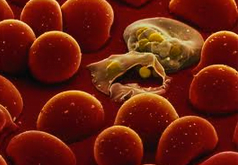Ed note. The mHealth Summit celebrates innovations in mobile technology that are improving health outcomes. This year, for the first time, the mHealth Summit includes a dedicated global health track. UN Dispatch welcomes freelance journalist Lois Parshley, who is reporting from the convention floor.You can follow her on Twitter at @loisparshley. – Mark
Every 30 seconds a child dies of malaria. Spread by mosquitos, malaria is most prevalent in the areas that are least equipped to deal with it – in rural, under-developed places with low-access to health-care and vulnerable populations. But malaria isn’t just a problem for the sick: According to UNICEF, even though $3 billion is spent on the disease every year, in sub-Saharan Africa it’s still responsible for 20 percent of child deaths and is a leading cause of stunted economic development.
Although malaria is preventable and treatable, it can be difficult to get an accurate diagnosis or appropriate care. In order to detect malaria, a doctor must usually check 100 to 300 “field-of-views,” or different perspectives. But this process can be tricky and is expensive; according to WHO, in sub-Saharan Africa around 60 percent of the cases reported are actually false-positives. But the Ozcan Research Group’s recent break-through may be about to change all that. Using a lensless holographic microscope on a mobile phone, a contraption that weighs about 45 grams but has cell resolution at a micron level, health workers are able to take photographs of slides of red blood cells. Since the identification process isn’t straight-forward, Ozcan’s idea of crowd-sourcing these cell-phone images — more rapidly, more accurately, and cheaper — is even more ground-breaking.
Ozcan has created an algorithm for the cell-phone microscope slides in order to use gaming communities to identify which patients have malaria. After a brief online training, users are instructed to try to visually identify the positive malarial slides. The algorithm determines the credibility of each user, using controls to weight each user’s likely accuracy, and combining multiple users’ responses for each slide. So far, more than 2,000 gamers in 70 countries have generated 1.5 million cell diagnoses.
In a sample size of 8,000 cell images, the crowdsourced data was within 1 percent of the accuracy of an expert diagnostician – a sample of whom were also given 8,000 cell slides to play with. Surprisingly, the experts’ accuracy within the program wasn’t any better, suggesting that this new program may quickly become a valuable resource even for trained pathologists.
Ozcan plans to create a library of images using this gaming platform to be an educational resource for experts and gamers alike. They also hope to expand the platform to work on other micro-analysis and diagnostics issues. Aydogan Ozcan, of Ozcan Research, has high hopes for their work, saying, “Like the transition from the development of the P.C. to the development of the Internet, this could be a major breakthrough.”
In an increasingly technological world, the new challenge is going to be not just collecting data, but scaling up how we sort data – making programs like Ozcan’s more essential than ever.
